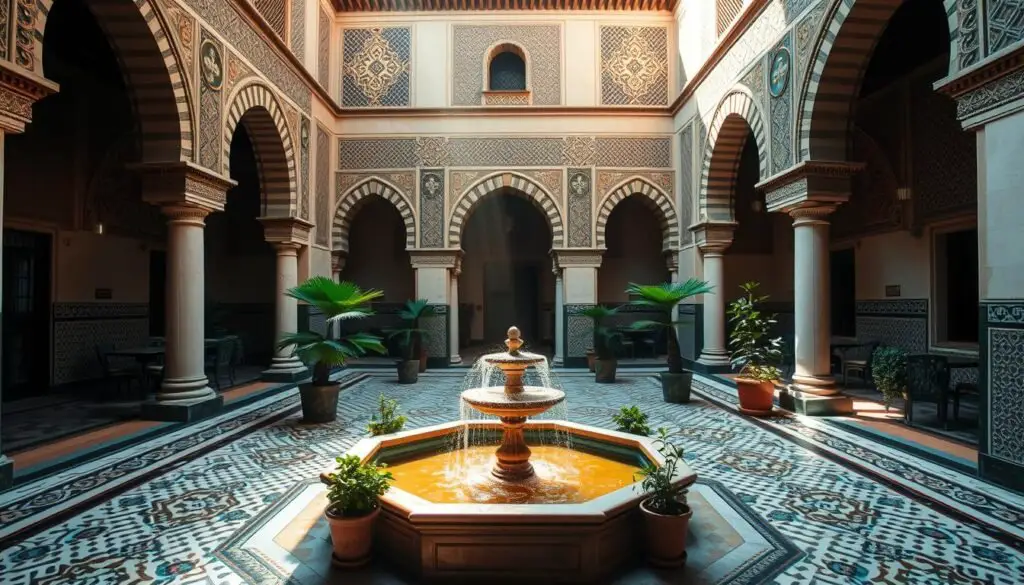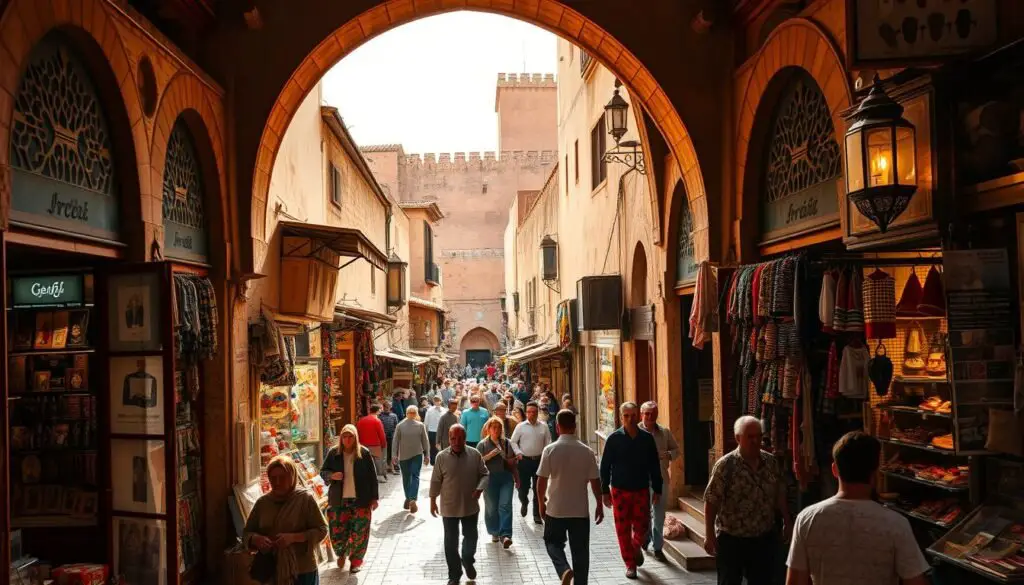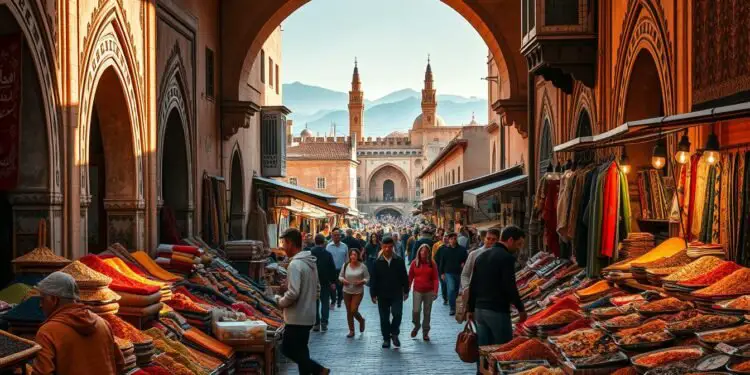Ever wondered what it’s like to step into a living medieval masterpiece? Fes, Morocco’s cultural heart, offers just that. With over 1,200 years of history, this UNESCO-listed city invites travelers to explore its labyrinthine streets, where time seems to stand still.
Founded in the 9th century, Fes el Bali is the world’s largest car-free urban area. Its medina, a maze of over 9,000 alleys, hides treasures like the iconic Chouara Tannery and stunning madrasas adorned with intricate mosaics. Two days here lets you soak in the rich heritage without feeling rushed.
From the Royal Palace’s golden doors to the historic Jewish Quarter, every corner tells a story. Nearby day trips to Chefchaouen or Volubilis add even more depth to your Moroccan adventure.
Key Takeaways
- Fes is Morocco’s cultural capital with UNESCO World Heritage status.
- The medina is the largest car-free urban area globally, perfect for walking.
- Spend at least two days to experience top attractions like the tanneries and madrasas.
- Historic sites span from the 9th-century Jewish Quarter to 14th-century Islamic schools.
- Easy connections to Marrakech and Chefchaouen make Fes a must-visit hub.
Explore the Historic Fes Medina
Few places capture Morocco’s soul like the tangled alleys of Fes. The 9th-century medina, a UNESCO World Heritage site, spans 540 acres with over 9,400 winding streets. It’s the largest car-free urban zone globally, where donkeys still haul goods past medieval mosques and madrasas.
Wander the Labyrinthine Alleys
Expect to get lost—it’s part of the charm. Google Maps often fails in the maze-like lanes. Gates close at night, so plan your day wisely. Locals recommend hiring an official guide or embracing the adventure with a paper map.
Visit the Iconic Bab Boujloud (Blue Gate)
The blue gate marks the medina’s main entrance. Its cobalt-blue tiles face outward, while emerald-green ones greet visitors inside—a nod to Islam’s colors. Built in 1913, this Moorish archway frames bustling cafes and street performers.
Discover the Vibrant Souks
The souks explode with color and scent. Bargain for handwoven rugs, spices piled like rainbows, and leather goods from the nearby tanneries. Watch for “helpful” kids offering directions—they often demand payment. For authenticity, stay in a riad within the medina walls.
Marvel at the Chouara Tannery
Time stands still at Chouara Tannery, where ancient leather-making traditions thrive. This UNESCO-listed site, operational for over 1,000 years, remains the world’s oldest functioning tannery. Its stone vats, filled with vibrant dyes, showcase techniques unchanged since medieval times.
Witness Traditional Leather-Making
Artisans soften hides using a mix of pigeon feces, lime, and vegetable dyes—methods passed down for generations. The result? Supple leather dyed in bold hues like saffron yellow and indigo. For deeper insight, join a tour to access the dye pits and avoid pushy vendors.
Best Viewpoints for Photos
Rooftop terraces offer the perfect view of the tannery’s kaleidoscopic pits. Arrive early for soft morning light and fewer odors—hold mint leaves under your nose if sensitive to smells. Access costs 50 dirhams, often included in guided tours.
Nearby shops sell bags, jackets, and slippers at negotiable prices. Bargaining is expected, so start low and enjoy the banter. This iconic stop captures Fes’s enduring artisan spirit.
Step Inside the Bou Inania Madrasa
A masterpiece of Islamic architecture awaits at the Bou Inania Madrasa. Built in the 14th century, this historic building showcases Morocco’s golden age with intricate zellij tilework and hand-carved cedar wood. Unlike many religious sites, it welcomes non-Muslim visitors for a 30-dirham fee.

The central courtyard dazzles with geometric mosaics and a marble fountain. Look up to admire the carved plaster ceilings and wooden screens. This active religious site requires modest dress—cover shoulders and knees.
Compared to Al Attarine Madrasa, Bou Inania is larger and more elaborate. Its green-tiled minaret towers over the medina. Visit after 4 PM for fewer crowds and softer light.
Pair your tour with the nearby spice market. The madrasa’s serene atmosphere contrasts beautifully with the bustling souks. Don’t miss the Dar al-Magana clock house just steps away.
Admire the Royal Palace of Fes
Golden gates and intricate tilework welcome visitors to Fes’s majestic Royal Palace. This 80-acre complex, known as Dar al-Makhzen, remains an active ceremonial site with seven stunning bronze-decorated entrances. Though the interior is closed to the public, the exterior showcases Morocco’s finest craftsmanship.
The Stunning Bronze Doors
Each gate features cedar wood panels adorned with geometric patterns and Arabic calligraphy. Gilt bronze accents catch the sunlight, while vibrant tiles frame the arches in kaleidoscopic designs. The Place des Alaouites gates are particularly photogenic at golden hour.
Nearby Gardens and Mosques
Just steps away, Dar Batha Museum’s gardens offer Andalusian-style landscaping with olive trees and bubbling fountains. The peaceful Lalla Mina Gardens provide another serene escape. For architecture lovers, the 14th-century Al-Qarawiyyin Mosque’s minaret towers over nearby buildings.
Pro tip: Arrive early for the best view and soft lighting on the palace’s ornate details. Combine your visit with the Mellah district to explore Fes’s layered history.
Uncover the Al Attarine Madrasa
History whispers through every tile at Al Attarine Madrasa, a 14th-century gem. Named after the adjacent spice market, this building dazzles with gold-leaf calligraphy and cypress wood ceilings. Built between 1323–1325, it reflects Morocco’s golden age of Islamic art.
The sunlit courtyard centers around a marble fountain fed by underground streams. Look up to admire intricate stucco work and vibrant green-and-white mosaics. Unlike larger madrasas, its compact size makes it perfect for a 30-minute visit.
Just steps from Kairaouine Mosque, the madrasa once trained scholars in Quranic studies. Today, its quiet halls contrast with the bustling Attarine Souk. Pair your tour with perfume shopping—the market’s saffron and amber scents linger in the air.
Pro tip: Arrive early to avoid crowds. The morning light highlights the carved arches and geometric patterns. Don’t miss the mihrab, adorned with Marinid-era craftsmanship.
Visit the Ancient Al-Qarawiyyin Mosque
Founded by a visionary woman, Al-Qarawiyyin Mosque shaped intellectual history. Fatima al-Fihri established this building in 859 AD, creating what UNESCO recognizes as the world’s oldest continually operating university.
The mosque’s grandeur reveals itself through ornate gates. Non-Muslims can admire the marble courtyard and arched prayer halls from the entrance. Geometric patterns and carved cedar wood showcase nine centuries of Islamic artistry.
For the best view, head to Cafe Clock’s rooftop terrace. Their mint tea pairs perfectly with panoramic medina vistas. Remember to dress modestly—covered shoulders and knees are required near religious sites.
This spiritual landmark once hosted scholars like Ibn Khaldun. Today, its library preserves rare manuscripts while the adjacent university continues teaching. A true wonder of the world, Al-Qarawiyyin remains Fes’ cultural cornerstone.
Stroll Through Jnan Sbil Gardens
A lush oasis unfolds behind Fes’ ancient walls, offering a refreshing escape from the medina’s buzz. Jnan Sbil Gardens spans seven acres of botanical displays, earning its nickname as the city’s “green lungs”. This peaceful area contrasts beautifully with the surrounding historic chaos.
Wander past Andalusian-style fountains and geometric flower beds bursting with seasonal color. The large central pond attracts water birds, perfect for quiet birdwatching. Shaded benches beneath palm alleys invite visitors to rest weary feet.
Open Tuesday through Sunday (8AM-7:30PM), the gardens make an ideal midday break. Nearby juice stands serve refreshing drinks to enjoy amid the tranquility. Morning visits offer the best view of floral displays with softer light.
Locals cherish this car-free sanctuary for picnics and relaxation. The cobblestone pathways lead past Mexican and Bamboo garden sections. Don’t miss the golden-hour glow on the medieval walls framing the gardens.
Discover the Jewish Quarter (Mellah)
Colorful balconies and whitewashed walls mark Fes’s historic Jewish enclave. Established in 1438 near the Royal Palace, this area was Morocco’s first planned Jewish district. Today, floral murals and ironwork balconies create a distinct street scene.
Ben Danan Synagogue
The 17th-century synagogue dazzles with herringbone tilework and carved cedar wood. Restored after its 1996 World Monuments Watch listing, it showcases exquisite geometric patterns. Non-slip tiles and preserved Torah arks reflect centuries of craftsmanship.
Jewish Cemetery
Blinding white tombs stretch across this 19th-century burial ground, renovated in 2019. Notable graves include Lalla Solica, a young martyr revered by pilgrims. The orderly rows contrast with the medina’s chaos, offering quiet reflection.
Guided tours provide cultural context about this unique Jewish quarter. Expect reasonable prices for half-day explorations. The Mellah’s layered history adds depth to any Fes itinerary.
Practical Tips for Visiting Fes
Smart travelers know preparation is key when exploring Fes’s historic heart. From seasonal timing to medina navigation, these insights ensure a smooth journey through Morocco’s cultural gem.

Best Time to Visit
Spring (March–May) and fall (September–November) offer mild weather, ideal for walking. Summer heat can exceed 100°F, while winter nights dip below 50°F—pack layers.
Plan a full day to explore without rushing. Mornings are cooler and less crowded, perfect for iconic sites like the tanneries.
Getting Around the Medina
The medina’s 9,000+ streets are car-free. Wear sturdy shoes—cobblestones are uneven. Offline maps like Maps.me help avoid getting lost.
For intercity travel, CTM buses are reliable. Taxis should use meters; agree on a price upfront to avoid overpaying.
Guided tours provide context in the labyrinthine alleys. Bargain politely—start at 30% of the asking price. Carry small bills and a scarf for modesty at religious sites.
Conclusion
Fes delivers an unforgettable journey through Morocco’s living history. From the vibrant Chouara Tannery to the serene courtyards of Bou Inania Madrasa, every moment immerses you in centuries-old traditions.
Wandering the medina’s maze-like alleys reveals hidden gems at every turn. Pair your trip with visits to Chefchaouen or Marrakech for a complete Moroccan adventure. Two days lets you soak in the culture without rushing.
Ready to explore? Pin this guide for your travels or grab a detailed book for deeper insights. Fes isn’t just a destination—it’s a doorway to another time.
FAQ
What is the best time to visit Fes?
Spring (March-May) and fall (September-November) offer pleasant weather, ideal for exploring the medina and historic sites without extreme heat.
Can you enter the Royal Palace of Fes?
No, the palace is closed to the public, but visitors can admire its grand bronze doors and surrounding gardens.
How do I get the best view of the Chouara Tannery?
Nearby leather shops provide rooftop access for panoramic views of the tannery’s colorful dye pits—often in exchange for browsing their goods.
Is the Bou Inania Madrasa open to non-Muslims?
Yes, this 14th-century madrasa welcomes all visitors to explore its intricate tilework and carved cedarwood courtyard.
Are guided tours worth it in Fes?
Highly recommended! A local guide helps navigate the medina’s maze-like alleys and shares insights about hidden gems like Al Attarine Madrasa.
What should I wear when visiting mosques?
Dress modestly (covered shoulders and knees). Non-Muslims cannot enter Al-Qarawiyyin Mosque but can view its exterior.
How many days should I spend in Fes?
Two to three days allow time to see key highlights, including the souks, tanneries, and Jnan Sbil Gardens.
Is the Jewish Quarter safe to visit?
Yes, the Mellah is safe. Don’t miss the Ben Danan Synagogue and the historic Jewish Cemetery.
What’s unique about Bab Boujloud?
The iconic Blue Gate, adorned with intricate tilework, marks the main entrance to the medina and looks stunning at sunset.
Are cooking classes available in Fes?
Yes! Many riads offer classes to learn traditional Moroccan dishes like tagine and pastilla.




